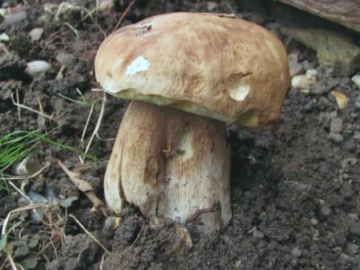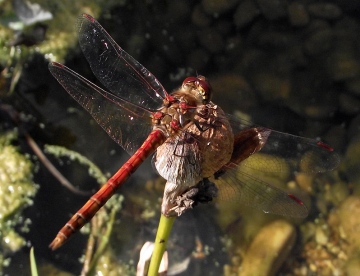What a difference a little rain makes. When I visited Fryerning Churchyard last Friday (September 2nd) there were few fungi to be seen, just a scatter of
Blusher Amanita rubescens and
Brown Roll Rim Paxillus involutus, many of which had bee kicked over by visitors. Today there were fungi everywhere! Virtually all the birch trees were ringed with
Leccinum sp., all of which keyed out as
Brown Birch Bolete L.scabrum in Geoffrey Kibby's new guide, while there were clusters of
Xerocomus cisalpinus (no English name as yet) at the base of many of the oaks. Several of the Churchyard's regular crop of
Brittlegills (Russula) were on view, the
Green R.aeruginea, Primrose R.sardonia, Coral R.velenovski, Purple R.atropurpurea, Bloody R.sanguinaria, and
Variable R.versicolor plus the delightfully named
Charcoal Burner R.cyanoxantha and
The Flirt R.Vesca, the last so named because the cap has a habit of raising the edge of its cap cuticle (skirt)!! There was also an addition to the churchyard list in the form of the
Crab Brittlegill R.xerempelina, this one named after its smell, probably long overdue given the number of pines in the churchyard. The pines had also produced a large crop of
Slippery Jack Suillus luteus and
Weeping Bolete S.granulatus while the Genus
Inocybe was represented by two common species, the
Star Fibrecap I.asterospora and
Fleecy Fibrecap I. flocculosa and the Genus
Agaricus by the
Scaly Wood Mushroom A. langei, which turns blood red in the frying pan, and the as yet to be named
A.impudicus. Other regular species were the
Russet Toughshank Gymnopus driophila, The Wood Woolly Foot G.peronata, Pink Domecap Calocybe carnea and
The Miller Clitopilus prunulus. Potentially, the best find of the day was a large
Bolete (pictured)found at the base of a Silver Birch. It looked like a pale version of the familiar
Penny Bun Boletus edulis but I normally associate this species with oak and there were none within 60-70 yards. Reference to Geoffrey Kibby's new key, though, suggested that it might be
B. betulicola, still treated as a variant of edulis by some authorities but considered by him and others to be a good species. The unusually pale colour of the cap, frequently inflated end cells to the otherwise long cells in the cap cuticle, and the tree associate all point to this species. The specimen has been retained.

Outside the churcyard there were several of the chunky, red staining, fish smelling, salt loving Agaricus bernardii growing in the splash zone on the roadside verges while the large oak on nearby Fryerning Green had a cluster of Scarlatina Boletus erythopus and Summer Bolete B.reticulatus in the shade of its branches along with two of its specialities, Boletus moravicus and the beautiful Chalciporus rubinus. At this rate we should be able to put on a good fungi display at the Grand Opening of the Club's new HQ on Saturday week.




















